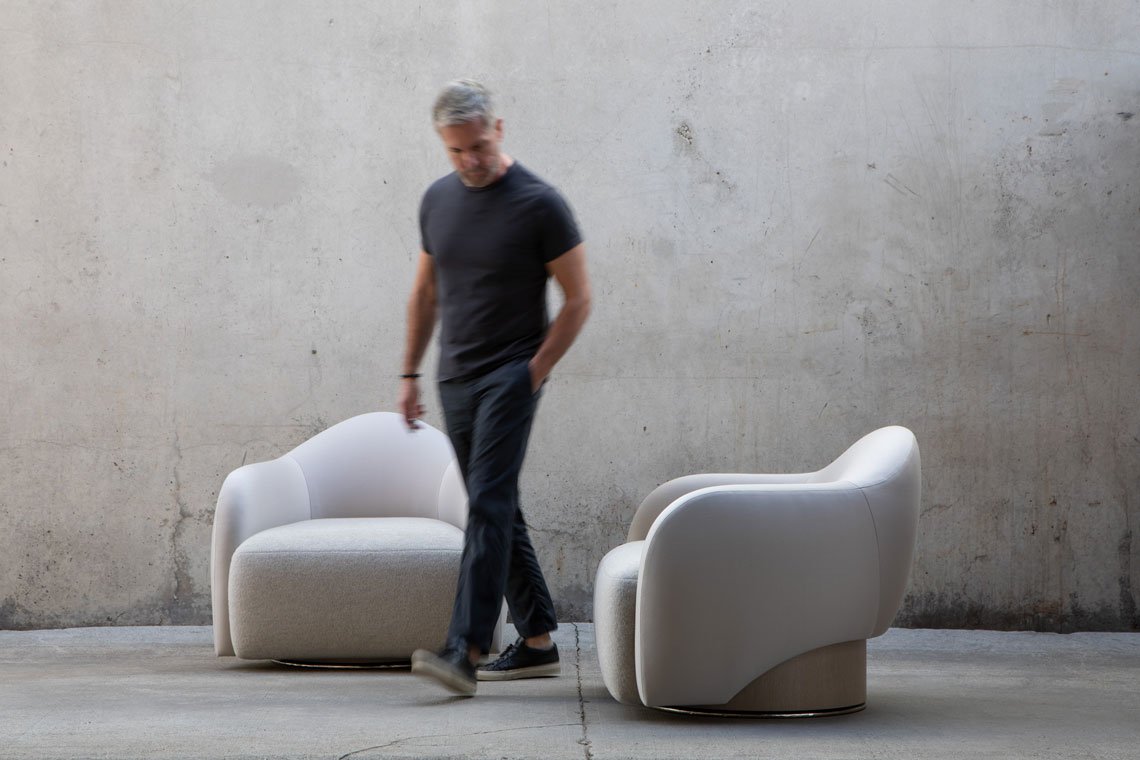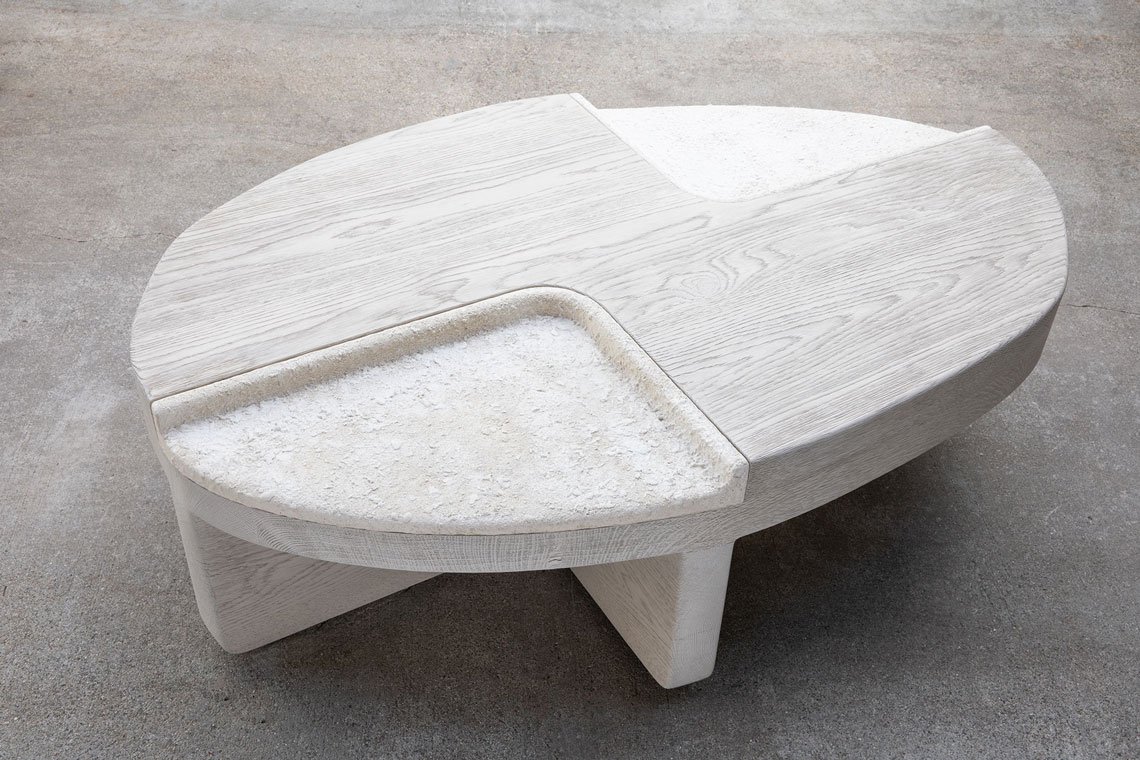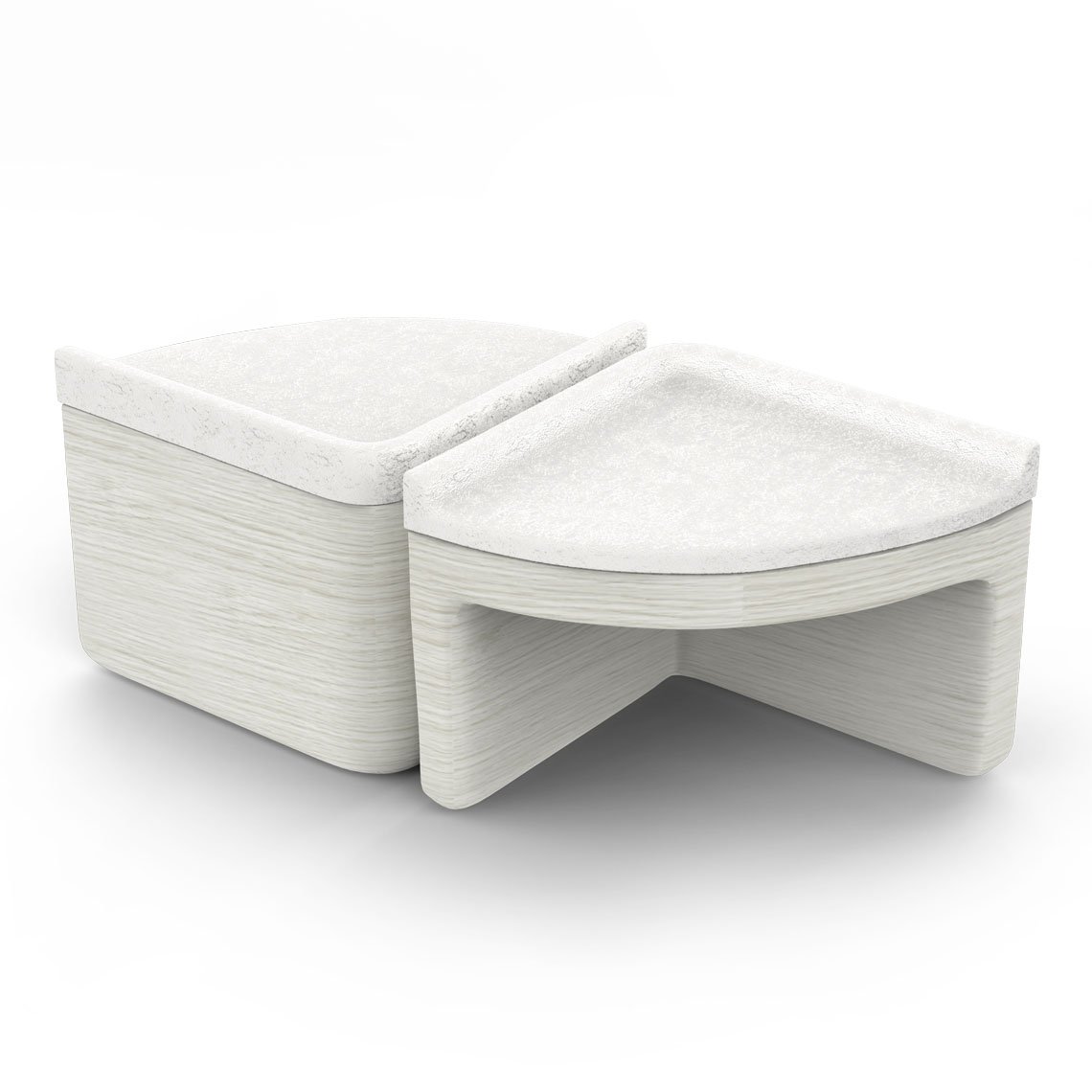Designer Robert Marinelli Takes On the World
 |
| Presenting Robert Marinelli’s new Dynamic Dialogue collection. The collection draws from Robert’s conceptual mood board of memories and impressions, including artistic and cultural artifacts from indigenous cultures, tones, and textures from natural habitats, and zoological forms. The collection is a gestalt referencing the natural world and our universal connectedness to it. Above: The aesthetics of a chair are expressed on many levels. Robert takes a perceptual reading, experiencing the nuances of his Cook swivel chairs. The design must resonate on a subliminal, emotional level to a degree that attunes with the physical; achieving that balance requires an intense focus on how the design communicates visually from all angles. |
Designer Robert Marinelli
Takes On the World
By Benjamin Genocchio
Robert Marinelli divulges that his latest collection is titled Dynamic Dialogue. He pauses for a moment as we sit at the ICFF (International Contemporary Furniture Fair) in New York to let the meaning of the words sink in, and adds: “It is about the conversation between individual designs and their multiple inspirations in the wider world, where the boundaries between contemporary design and art are blurred.”
Marinelli is that rare breed in the design world — a designer of honed sensitivity to the aesthetic as well as the functional qualities of objects. He brings a fierce, questioning intelligence to what he is doing, ceaselessly pushing himself creatively.
 |
| The Goyah Armchair and Goyah Side Chair’s knobby contoured legs are an abstract representation of the legs of mountain goats. Finding it difficult to communicate to the furniture artisans exactly what he wanted, Robert (literally) took matters into his own hands, sculpting the prototype in clay. The wavy contour line defining the chairs’ bouclé upholstered upper section ties to the goats’ habitat, an abstract visual metaphor for a snow-capped mountaintop. |
 |
| Heavily sandblasted white oak and removable trays in a weathered surface of cast concrete are expressive materials that emphasize organic texture. The design evolved from Robert Marinelli’s fascination with face masks made by the Bembe tribe in central Africa. |
“I think when most people create collections of contemporary furniture or objects, each piece tends to have a similar narrative or inspiration and so they can all look very related. But when I design, I don't design in that traditional box. I create pieces that are unique unto themselves, which are fundamentally different and have disparate inspirations.” Hence the title of his new collection.
Marinelli notes this doesn’t mean the pieces in his new collection are unrelated. “When some people look at my designs they say, ‘Well that is not a collection. You have 10 pieces here and they are all different, there is no aesthetic continuity.’ So they don’t consider it a collection. But there is a more intuitive, more organic association between them. I am not designing for everything to look as if it was derived from the same thought process or materials, but rather to reveal the common threads.”
The forms Marinelli has created for his collection relate visually and belong together — soft edges, sinuous shapes, and organic forms predominate. The current collection is also united in terms of color, modulations of neutral off-white and soft gray, as well as an attention to surface in his use and choice of materials that include wood, concrete, and a range of textured fabrics.
“Neutral colors are easier for people,” he says “Given the diversity of forms I create, I have found that sticking to one color for a collection means the designs are presented in the softest way for people to take in.” He is working on an iteration of the current collection entirely in matte black, he says, “as a sort of experiment, for a different mood,” which is forthcoming.
Other, more important elements that make this collection cohesive, such as the inspiration for the collection overall. “Every piece I design needs to have a personality, a visual identity, and this is where the inspiration comes in. Animals, natural habitats, and indigenous cultures were the starting point for this whole collection,” he says, “and is reflected in the names of the pieces.”
 |  | |
| Left: The Bembe Console, in weathered white oak with a tray in textured cast concrete. Right: The Bembe Drinks Table. | ||
Marinelli’s Bembe table takes inspiration from the ceremonial masks made by the Bembe people from the Democratic Republic of Congo, in Africa. “Bembe is the name of a Congolese tribe,” Marinelli says. “I was inspired by Bembe ceremonial masks I saw in the Oceanic Wing at the Metropolitan Museum of Art. I have always been strongly drawn to the Oceanic tribal wing at the Met, the masks especially, with exaggerated proportions in the eyes, tongue, or the mouth, and so to me the Bembe table without the cast concrete trays is a kind of human face or mask.
The Bembe table, part of a series that includes the low table, console table, and side tables, took quite a bit of development. Marinelli first experimented with various techniques and the textures they produced before deciding on sand-blasting the wood to get the color and surface he was looking for. Initially, he intended the trays to be cast from bronze, but the material felt too noble and unharmonious in context with the inspiration, he says. He then considered ceramic, but it felt too “in vogue.” While working on the renovation of a home in Manhattan he hit upon the idea of casting the trays in concrete and found that the material could be manipulated while still damp to create just the right amount of grit, texture, and organicity he needed.
The scale, proportion, and quality of the work link Marinelli’s current collection to his previous one, exhibited at the Bernd Goeckler Gallery in New York in 2019. But the forms, materials, and certainly their inspiration are a deliberate shift away from his other, earlier work.
 |
| With tactile textures more elegant than earthy, and contemporary sculptural forms referencing the natural world and indigenous cultures, Robert Marinelli’s Dynamic Dialogue collection taps into an important message about our universal interconnectedness and the delicate balance of living in harmony with the natural world. |
Marinelli’s carved Goyah side chair and armchair are intentionally sculptural and the design required a great deal of trial and error to get a chair that would work in the many environments of a home. “It took forever for me to get that shape, specifically the wobbly shape of the legs. I was having trouble explaining it to the artisans I was working with, so I bought clay and sculpted the legs myself. They were then scanned and carved with a CNC machine so a master craftsman could recreate the wobbly form I wanted.”
Part of the objective for these chairs was to fulfill the desire to create sculptural furniture that could be appreciated in the round. “Most furniture looks good from the front — and that’s it. When I design furniture, I am always looking at it from 360 degrees. How it looks from the front, back, the side, all these viewing angles — they are all the things I take into consideration. I am not assuming I understand the space it is going into.”
 |
| Upholstered in goat fur to reference the mountain goat’s thick and fluffy coat, the Goya Ottoman ties together characteristics from both the Goya Series and the Bembe Series, its mask-shaped surface and deeply textured legs forming a stylistic bridge to those elements featured in the Bembe Series. |
 |
| The Bembe Series ovoid mask leitmotif is reinterpreted for the Goya Ottoman. |
The chairs work equally well as dining, entryway, or occasional chairs, and wherever they’re used doesn't matter because they are so expressive they can be appreciated from any viewpoint. “The idea of making sculptural furniture is so that it can just float in any space,” he says. Marinelli sought inspiration from the natural world for these designs. “The legs of the chair reference the knobby legs of mountain goats,” he tells me. The curvy line where the fabric meets the back frame of the chair is meant to represent the mountain range on which the goats climb, and the bouclé upholstery fabric is a metaphor for their snow-capped natural habitat. A third piece in this series, the Goyah Ottoman, continues the theme with fluffy goat fur upholstery similar to the dense coat of the mountain goat.
The Cook swivel chairs are an intriguing addition to the new collection. Soft and cloud-like with an almost meditative purity of form, the texture and proportions work on the subliminal level to channel organic associations. Marinelli’s Cook swivel chair and the related Boomerang Sofa were commissioned by a private client to “coexist, embrace, and act as a bridge between the Goyah and Bembe series in the same space,” he tells me. Conceived to be viewed from the side and back, the Cook chair expresses a modernist adaptation of free-standing, Oceanic tribal sculptures.
 |
| The Boomerang Sofa and Side Chair from designer Robert Marinelli’s new Dynamic Dialogue collection reimagines the aerodynamic profile of the boomerang, its form composed of a hybrid of angles and curves, and a subtle tapering incline on the backrest. |
Marinelli sought inspiration for his Boomerang sofa from the original function and design of a boomerang. Several past American designers have created similarly shaped sofas, including Edward Wormley and Milo Baughman, but in this instance, his inspiration originates in Australia among the Indigenous Aboriginal people who used the boomerang as a weapon. The obtuse, curved design of the sofa mimics an actual boomerang in every way, with one side flat and geometric and the other convex, curving outward, which enables the boomerang to fly circularly.
Marinelli views his new designs as an evolution of where he wants to go creatively. “I didn't want my next collection to be so far from my original work but more of a gradual transition so that I can see where I started relative to where I am going. Certainly, this is a shift towards more figurative forms and less functional furniture.
“My previous collection was definitely architectural,” he says. “Those forms that I created were more like buildings and had mid-century inspirations. The new pieces were designed to make people connect more closely with their natural environment and are made from sustainable materials, notably concrete which I have never used previously.”
A show of the new collection is planned for this fall and the artist is beginning to explore options for the right context. “Being an artist isn’t just about creating,” he says “but managing how a body of work is presented and challenging outdated perceptions of a “designer” and conventional boundaries between the worlds of contemporary design and art.”
 |
 |
View the full limited edition "Dynamic Dialogue" collection by Robert Marinelli



























